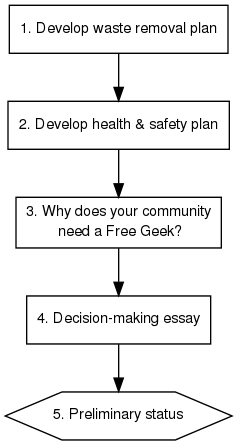Difference between revisions of "Talk:Trademark application flow chart"
| Line 67: | Line 67: | ||
incorporation [label="Incorporate"] | incorporation [label="Incorporate"] | ||
bylaws [label="Develop and submit\nBylaws"] | bylaws [label="Develop and submit\nBylaws"] | ||
| − | + | charity [label="Apply for charity status"] | |
space [label="Acquire space"] | space [label="Acquire space"] | ||
finalapp [label="Fill out final application"] | finalapp [label="Fill out final application"] | ||
| Line 80: | Line 80: | ||
vendors -> incorporation | vendors -> incorporation | ||
incorporation -> bylaws | incorporation -> bylaws | ||
| − | bylaws -> | + | bylaws -> charity |
| − | + | charity -> space | |
space -> finalapp | space -> finalapp | ||
finalapp -> rejected2 | finalapp -> rejected2 | ||
Revision as of 21:20, 19 September 2008
A very early step should be something like "Demonstrate you know what it means to be a Free Geek". In this step folks should show that they know the principles and have an idea of what kinds of programs they'd offer. They should be able to explain why a Free Geek is a non-profit, rather than a for profit business. They should have a reasonable understanding of what non-hierarchical means. They should be able to write about responsible recycling and use the word "reuse" without being prompted by us. If they can't talk their way out of this step, there's no reason to make them research recycling partners, etc. (Too much work for them and us.)
Another early step should be about communication. They should be able to at least give us email addresses and sign up for the startup lists. We should have names and contacts of two or three people.
They should also have a general "inventory" or resources in their community, namely:
- technical volunteers
- social worker type volunteers
- some recycling outfits they might work with
RfS 02:14, 3 September 2008 (UTC)
The flow chart we're discussing aims to amend our current process, which can be found here:
Free Geek Startup Franchise Application
I'm the new guy but here's what I think. For the most part, I think we know a lot of the things that we want to know about applicants. It's just become an information flow problem once we try to get that information.
One part of it is in the application processing on our end. There is no process there yet. I think that Ifny's suggestion to tag applications and put them on certain tracks so that we have good time-lines for processing is good.
Then there is the format of the applications. Right now we ask general questions of preliminary applicants and then tighten the screws and ask for specifics in the ongoing status application. Though I understand that this movement from general to specific was probably implemented to give preliminary startups a chance to get green-lighted and then work out kinks later, in the end I think it actually might do a disservice to applicants that aren't right for the organization by allowing them wiggle room; it creates more work for us because we're asking a lot of questions twice; and it becomes an information battle between people writing and reading very long emails (see Trademark queue in RT).
We know what we want. Let's advertise that clearly, require regular reports and numbers, as David suggests. Place the responsibility on all of us to make reports. Because we don't have the resources to perform audits.
Another idea: shift the questioning away from "what do you plan to do?" to "what are you doing?" We all know what we want to be doing. It's in our principles, it's on the wiki. An observation about human nature: when we ask people about their plans and then ask follow-up questions about their plans it makes them wax poetic at length. Especially when they haven't actually started doing any of it. Instead, ask them what they have been doing. That gets us all into a certain mind-set of reporting what we're doing: we do our homework, we follow the principles, we make reports about what we're doing.
In order to shift from the first type of questioning to the more direct one, we simply ask specific questions first according to this flow chart. Let us see your vendor list. Let's see who you've called. Let's see what BAN (or anyone else) has said about your area. Let's see your health and safety plan. Things like that.
Thanks for reading.
Ian 00:17, 6 September 2008 (UTC)
We know what we want
- We know what we want. Let's advertise that clearly, require regular reports and numbers, as David suggests. ...
I'd like spelled out in one place the things we know, rather than assume we know it. Our concerns are scattered all over the place right now. Some of the flowchart as it stands seems too abstract to me. There should be a specific list of points, which is what I was thinking about the flow chart.
No problems with many of the process ideas that have been suggested, but I want to see a concrete list of steps listed somewhere.
RfS 18:37, 12 September 2008 (UTC)
My idea of a useful flowchart
RfS 16:47, 19 September 2008 (UTC)
Something like the following, which shows several straightforward steps to be accomplished. We could have a paragraph explaining each step and why it is important, and point to resources for accomplishing that step.
I would also state clearly that we expect reporting to the franchise list (or somewhere else if we want) during this process, so we can identify problems as they develop and point people in a useful direction. (Once ongoing status is achieved, regular reporting would continue. But while this process is happening, the reporting would likely be more interactive and less formatted.)
Caveat: some of these steps could happen in a slightly different order.
